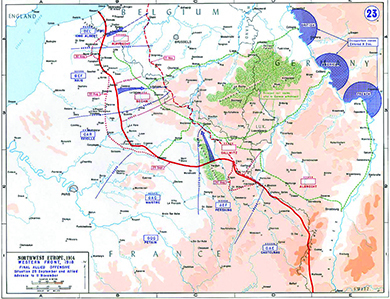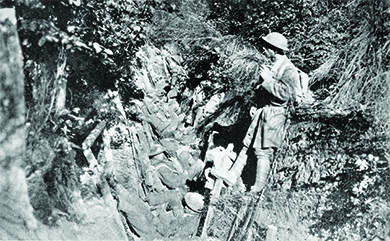| << Chapter < Page | Chapter >> Page > |

Wounded in his shoulder by enemy forces, George, a machine gunner posted on the right end of the American platoon, was taken prisoner at the Battle of Seicheprey in 1918. However, as darkness set in that evening, another American soldier, Charlie, heard a noise from a gully beside the trench in which he had hunkered down. “I figured it must be the enemy mop-up patrol,” Charlie later said.
I only had a couple of bullets left in the chamber of my forty-five. The noise stopped and a head popped into sight. When I was about to fire, I gave another look and a white and distorted face proved to be that of George, so I grabbed his shoulders and pulled him down into our trench beside me. He must have had about twenty bullet holes in him but not one of them was well placed enough to kill him. He made an effort to speak so I told him to keep quiet and conserve his energy. I had a few malted milk tablets left and, I forced them into his mouth. I also poured the last of the water I had left in my canteen into his mouth.
Following a harrowing night, they began to crawl along the road back to their platoon. As they crawled, George explained how he survived being captured. Charlie later told how George “was taken to an enemy First Aid Station where his wounds were dressed. Then the doctor motioned to have him taken to the rear of their lines. But, the Sergeant Major pushed him towards our side and ‘No Mans Land,’ pulled out his Luger Automatic and shot him down. Then, he began to crawl towards our lines little by little, being shot at consistently by the enemy snipers till, finally, he arrived in our position.”
The story of Charlie and George, related later in life by Sgt. Charles Leon Boucher to his grandson, was one replayed many times over in various forms during the American Expeditionary Force’s involvement in World War I. The industrial scale of death and destruction was as new to American soldiers as to their European counterparts, and the survivors brought home physical and psychological scars that influenced the United States long after the war was won ( [link] ).

By the end of September 1918, over one million U.S. soldiers staged a full offensive into the Argonne Forest. By November—after nearly forty days of intense fighting—the German lines were broken, and their military command reported to German Emperor Kaiser Wilhelm II of the desperate need to end the war and enter into peace negotiations. Facing civil unrest from the German people in Berlin, as well as the loss of support from his military high command, Kaiser Wilhelm abdicated his throne on November 9, 1918, and immediately fled by train to the Netherlands. Two days later, on November 11, 1918, Germany and the Allies declared an immediate armistice, thus bring the fighting to a stop and signaling the beginning of the peace process.

Notification Switch
Would you like to follow the 'U.s. history' conversation and receive update notifications?